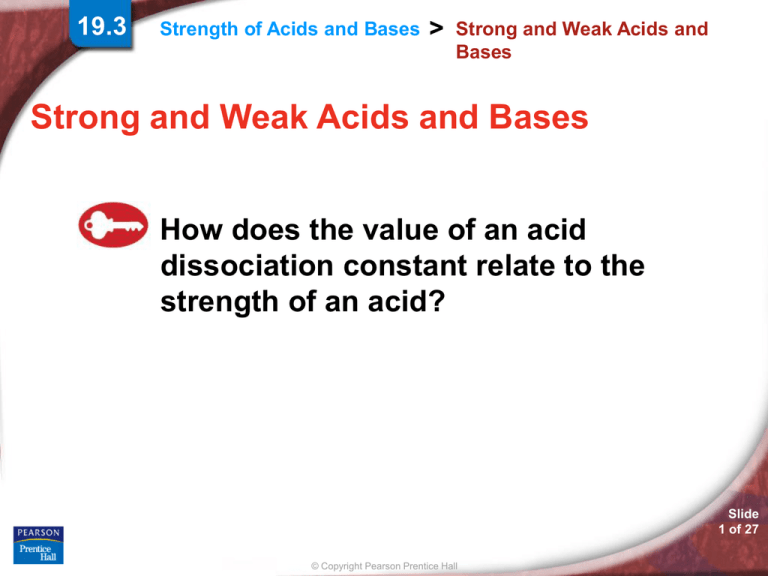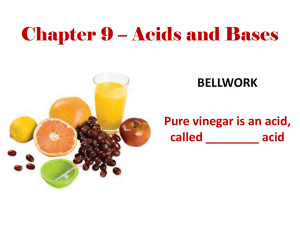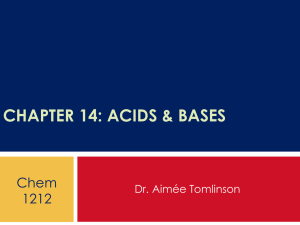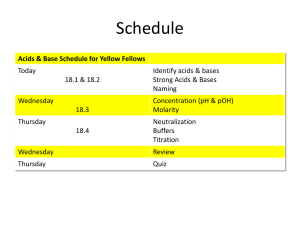
19.3
Strength of Acids and Bases
>
Strong and Weak Acids and
Bases
Strong and Weak Acids and Bases
How does the value of an acid
dissociation constant relate to the
strength of an acid?
Slide
1 of 27
© Copyright Pearson Prentice Hall
19.3
Strength of Acids and Bases
>
Strong and Weak Acids and
Bases
An acid dissociation constant (Ka) is the ratio
of the concentration of the dissociated (or
ionized) form of an acid to the concentration of
the undissociated (nonionized) form.
Slide
2 of 27
© Copyright Pearson Prentice Hall
19.3
Strength of Acids and Bases
>
Strong and Weak Acids and
Bases
Weak acids have small Ka values. The
stronger an acid is, the larger is its Ka
value.
Slide
3 of 27
© Copyright Pearson Prentice Hall
19.3
Strength of Acids and Bases
>
Strong and Weak Acids and
Bases
Strong acids are completely ionized in aqueous
solution.
Weak acids ionize only slightly in aqueous
solution.
Slide
4 of 27
© Copyright Pearson Prentice Hall
19.3
Strength of Acids and Bases
> Calculating Dissociation
Constants
Slide
5 of 27
© Copyright Pearson Prentice Hall
19.3
Strength of Acids and Bases
>
Strong and Weak Acids and
Bases
In general, the base dissociation constant (Kb)
is the ratio of the concentration of the conjugate
acid times the concentration of the hydroxide ion
to the concentration of the base.
Slide
6 of 27
© Copyright Pearson Prentice Hall
19.3
Strength of Acids and Bases
>
Strong and Weak Acids and
Bases
Strong bases dissociate completely into metal
ions and hydroxide ions in aqueous solution.
Weak bases react with water to form the
hydroxide ion and the conjugate acid of the
base.
Slide
7 of 27
© Copyright Pearson Prentice Hall
19.3
Strength of Acids and Bases
>
Strong and Weak Acids and
Bases
Slide
8 of 27
© Copyright Pearson Prentice Hall
19.3 Section Quiz.
1. H2S is considered to be a weak acid because it
a. is insoluble in water.
b. ionizes only slightly.
c. is completely ionized.
d. is dilute.
Slide
9 of 27
© Copyright Pearson Prentice Hall
19.3 Section Quiz.
2. Calcium hydroxide, Ca(OH)2, is a strong base
because it
a. has a large Kb.
b. has a small Kb.
c. forms concentrated solutions.
d. is highly soluble in water.
Slide
10 of 27
© Copyright Pearson Prentice Hall
19.3 Section Quiz.
4. The Ka of three acids is given below.
(1) 5.1 10–3
(2) 4.8 10–11
(3) 6.3 10–5
Put the acids in order from the strongest acid to the
weakest acid.
a. 1, 3, 2
b. 2, 3, 1
c. 3, 1, 2
Slide
11 of 27
d. 2, 1, 3
© Copyright Pearson Prentice Hall
19.3 Section Quiz.
5. The Kb of four bases is given below.
(1) 7.41 x 10-5
(2) 1.78 x 10-5
(3) 4.27 x 10-4
(4) 4.79 x 10-4
Put the bases in order from the strongest base to the weakest base.
a.
2, 3, 4, 1
b.
2, 1, 3, 4
c.
4, 3, 1, 2
d.
1, 4, 3, 2
Slide
12 of 27
© Copyright Pearson Prentice Hall
19.3 Section Quiz.
3. If the [H+] of a 0.205M solution of phenol
(C6H5OH) at 25ºC is 2.340 10-6, what is the
Ka for phenol? Phenol is monoprotic.
a. Ka = 2.67 x 10-11
b. Ka = 1.14 x 10-5
c.
Ka = 5.48 x 10-12
d. Ka = 1.53 x 10-3
Slide
13 of 27
© Copyright Pearson Prentice Hall
END OF SHOW











